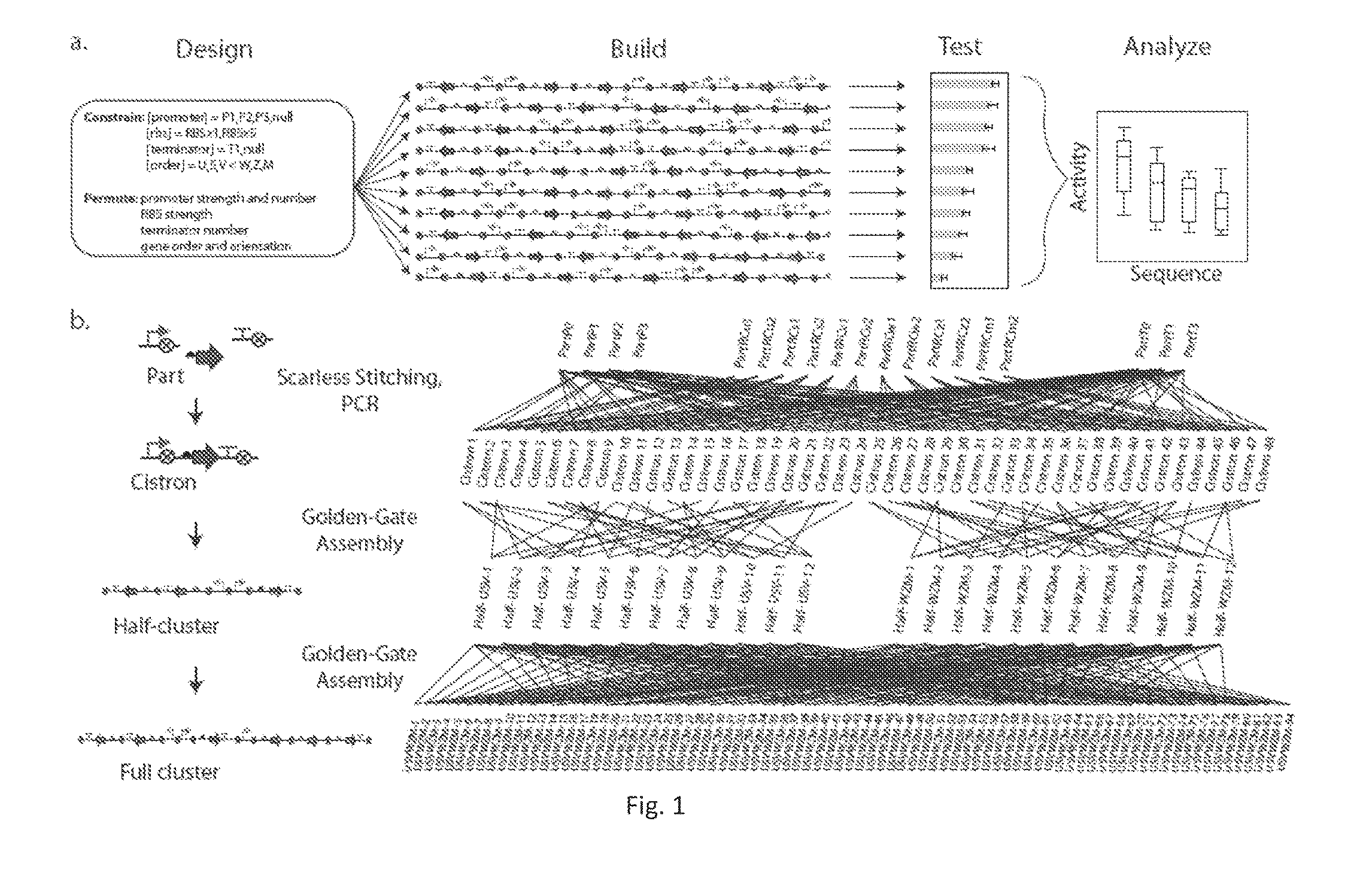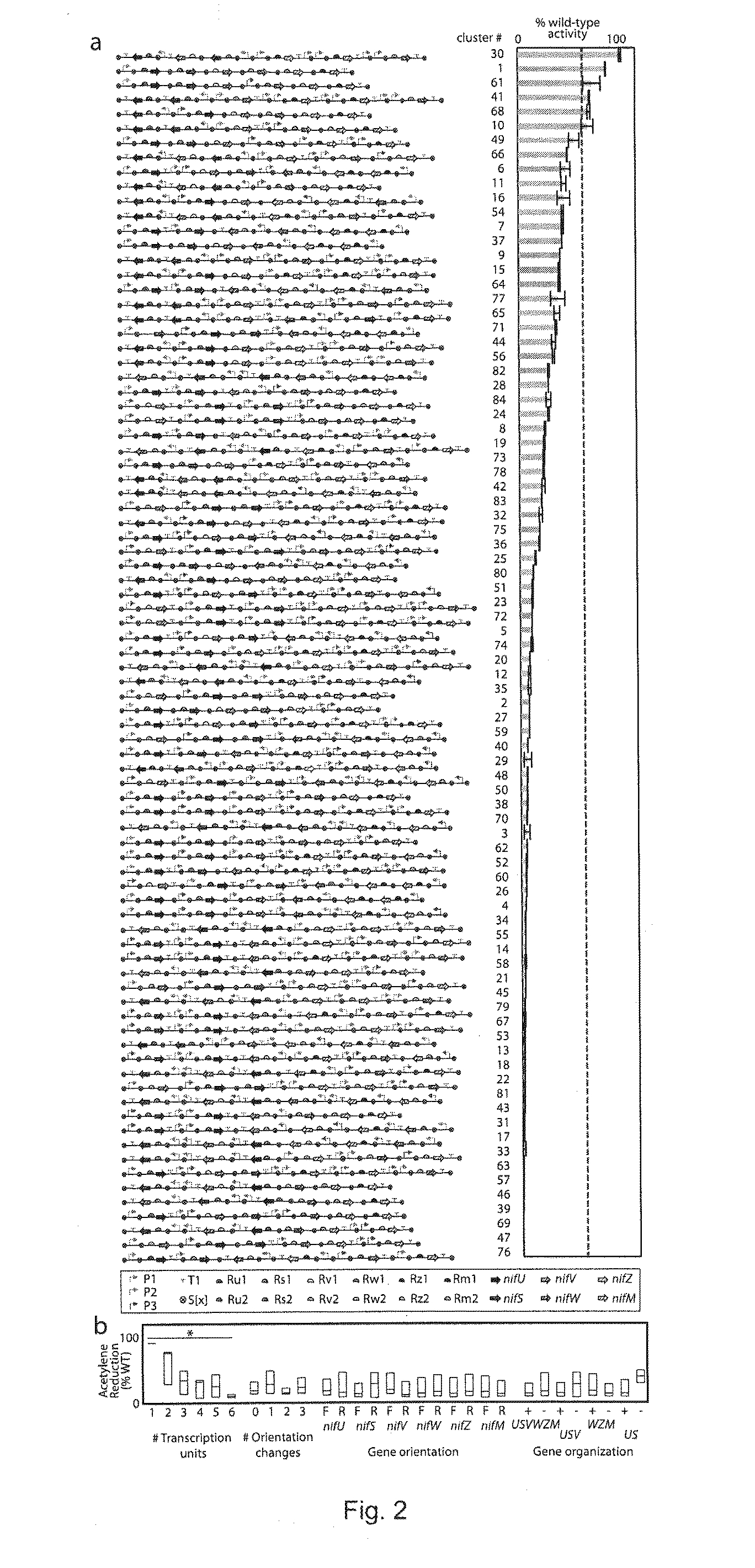Directed evolution of synthetic gene cluster
a synthetic gene and cluster technology, applied in the direction of nucleotide libraries, instruments, library creation, etc., can solve the problems of difficult design process, difficult to engineer large systems composed of many genetic parts, and difficulty in achieving the effect of large-scale genetic engineering
- Summary
- Abstract
- Description
- Claims
- Application Information
AI Technical Summary
Benefits of technology
Problems solved by technology
Method used
Image
Examples
example 1
[0123]A goal of the work described herein was to overcome the challenges of engineering complex pathways that are often very large and genetically complex. The current process of genetic design and transfer of a system to a new host, involves the laborious steps of assembling parts into a single construct or the creation of random library with a defined type of diversity (e.g., random mutagenesis or part insertions). The examples of the invention described herein exploit the modularity of a refactored nif gene cluster to build permutations that have dramatically reorganized genetics that could not be achieved starting from the wild-type cluster, as is the typical approach using currently available methods. The methods described within are also useful with any other gene cluster. First, 84 variants of the nifUSVWZM operon were constructed that differ in regulatory parts and architecture (gene order, orientation, operon occupancy). Expression of one of the variant gene clusters achiev...
example 2
Design and Characterization of Synthetic Genetic Parts
[0155]The relative expression units (REUs) were determined as a measure of promoter strength for each of T7 promoters used in library design and construction. Promoter strength was calculated using a slightly different method than previously reported (Temme, K., et al. 2012). T7 promoters used in this study were measured by cloning them into the P23100 locus of the internal standard plasmid N110. By maintaining the same RBS in the measurement plasmid and the internal standard, we can bypass the RBS Adjustment step when calculating REUs (Temme, K., et al. 2012). The adjusted protocol is outlined in FIG. 7A, along with the experimentally determined promoter strengths (FIGS. 7A and 7B).
[0156]Two ribosome binding sites for each CDS in the nif gene cluster were implemented in the library design and construction. The RBS from the original refactored gene cluster2 was reused and is given the label R[x]1, where [x] is a lowercase letter ...
example 3
Library Description Using EUGENE
[0161]The nifUSVWZM library samples a small set of possible designs from a large design space. Eugene is a specification language (Bilitchenko, L., et al. 2011) for describing design sets combinatorially. In a Eugene specification, a designer defines a library of genetic parts mapped to their part types, and using these part types, defines the abstract structure for a library of genetic designs. Eugene takes as input the parts library and rules that constrain how parts are allowed to be combined and produces an exhaustive list of designs that fit the abstract design defined in the specification. This design space is defined by the parts library and the abstract design.
[0162]The parts of the nifUSVWZM library are described by defining promoter, spacer, RBS-gene, and terminator parts. The design space is constrained with the following rules: (i) a gene cluster is composed of between one and six operons, (ii) each cluster contains exactly one copy of eac...
PUM
| Property | Measurement | Unit |
|---|---|---|
| flow rate | aaaaa | aaaaa |
| size | aaaaa | aaaaa |
| time | aaaaa | aaaaa |
Abstract
Description
Claims
Application Information
 Login to View More
Login to View More - R&D
- Intellectual Property
- Life Sciences
- Materials
- Tech Scout
- Unparalleled Data Quality
- Higher Quality Content
- 60% Fewer Hallucinations
Browse by: Latest US Patents, China's latest patents, Technical Efficacy Thesaurus, Application Domain, Technology Topic, Popular Technical Reports.
© 2025 PatSnap. All rights reserved.Legal|Privacy policy|Modern Slavery Act Transparency Statement|Sitemap|About US| Contact US: help@patsnap.com



